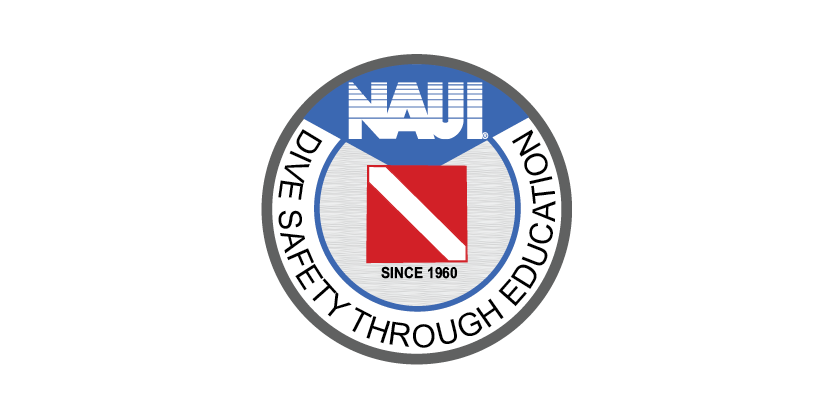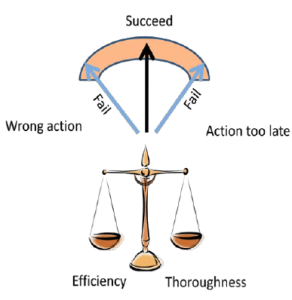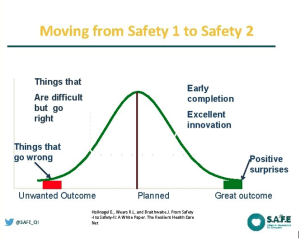Moving into Chapter 3 of ‘Forever Improving the Diver’, I am very excited to see the title resonating with individuals and prompting responses and input. I would like to thank Bruce Higgins for providing his interesting read on ‘Safety’, which addresses the balancing of efficiency and thoroughness.
Bruce starts the article acknowledging he is no safety expert but relies on subject matter experts for guidance.
“I’m no safety expert so I look to safety experts to find concepts that I can apply to my diving. Not that I feel unsafe but to enhance myself with what the experts are advancing.” – Bruce Higgins
For this discussion I want to share what I’ve learned from one author – Erik Hollnagel (references at the end). His first concept is that of Efficiency – Thoroughness Trade Off (ETTO) which is a balancing act in play about safety. You can be efficient but maybe not very thorough or you can be thorough / exhaustive but now you are not very efficient.
So how do I apply this to diving?
First, I notice the choice of terms use in that ‘efficiency’ implies that there are efficient ways to accomplish tasks and I should look at ways I do things that are successful plus efficient. Some interchange the word ‘effective’ but I tend to think effective translates into just barely efficient – a minimum.
As an example, I’m not very efficient guessing where my tank band goes for my BC placement. Once I’ve marked my favorite height with tape then I’m efficient placing my equipment set up for use. Now I could be more thorough and use a tape measure to know the distance between the tank valve and the top of the band so I could use any tank size but in reality, I have my own tanks, so I just label them up and the times I’m guessing is when I’m using a rental tank or begging for a buddy’s – which is not very often.
The second term is ‘thorough’ which is how complete I am. If I am thorough, then I consider all the risks involved and try to tip the balance toward safety. I could become thorough and spend hours completing research on a dive site, but I could also just ask a local about my specific questions and scope out the site with a snorkel visit before I gear up with scuba. Some might refer to this as “analysis paralysis”, where the dive never takes place since there is still yet endless research needed to complete. The tradeoff being efficient enough and thorough enough which is a balancing act not an OR situation.
You may sense when things are out of whack since you rushed. I think of this as diving’s pace since it is a recreation. I’m not striving for perfection but the balance between efficient enough to have fun and thorough enough to not be surprised in a bad way leading to an OOPS with a safety issue.
In teaching / coaching / mentoring you need the balance as well. Having a tiered approach by doing the important / urgent assessment helps me find the balance for all my diving phases. Something that I think applies throughout the entire dive as I endeavor to balance dive progress with gas consumption. After all, in recreation there are regional concerns that make this balance in many cases site and profile specific.
My take home is that I look both at my thoroughness actions and my efficiency procedures to make sure I’m not compromising one for the other but all-in-all balance the needs of each for fun recreation.
In the second Hollnagel safety concept he labels it as ‘Safety II’. When you look at the DANâ annual report the focus is on mishaps – “less than desirable outcomes you see year after year the same list of concerns about diving” – this is Hollnagel’s ‘Safety I’ – exploring mishaps.
Hollnagel suggests we spend equal or reasonable attention / time on things that went better than expected so we can learn to have more positive outcomes and rewarding experiences. This does not mean ignoring the bad outcomes but paying some attention and analysis efforts to the wildly successful events as well. There are the war stories about how you saw the most spectacular ‘X’ and wish you could see it again. That would be understanding and researching what caused the success to occur (Safety II). Success is not potluck but happens for a reason and attention to find that reason so it can be repeated is worth the effort. In training / coaching / mentoring discussions about what has worked well is the kind of advice we like to give. The tales about failure never lead to a silver bullet that just changing one thing is going to guarantee success.
I’m sorry that the focus on mishaps is interesting but when I spend more energy on what went well and try to do that, I feel better about what I’m doing and avoid the negative. DAN’s list of “Causes” has not changed in years neither has the quantity of mishaps. As a recreation I am not satisfied with the same level of mishaps year after year so I would hope the community could do better. As a safety focused organization shouldn’t we be reducing the quantity with a secondary approach like looking at makes the recreation more enjoyable? I for one have changed my mind on several things which have led to more enjoyable diving.
One case in point is not just asking my buddy’s air pressure but reading their gauge directly to see what they are seeing as well as showing them my pressure gauge. Heavens, I must be close enough to my buddy to read it which has helped me more than once from being separated from my buddy. In my neck of the wood’s visibility can be challenging so keeping in touch with my buddy’s air and them with mine avoids us getting too far apart. Worse case, my buddy’s pressure gauge is my leash to hang on to when silt seems to come in from nowhere. Trying to puzzle out my various buddies’ various methods of counting how much gas they have via hand signals has turned into a mess. In my case black fingers (since we wear black gloves) on a black exposure suit is a guessing game; but when I actually read the gauge, I am seeing what they are seeing.
Looking back at these two suggestions might also reflect that safety is not a stagnant subject and progress is being made outside of the scuba community that we can apply. As they say it is not ‘practice make perfect’ but ‘perfect practice makes perfect’ so as our diving adventures continue, we strive for better practice for those perfect dives. To me the scuba community currently ignored the safety community which has been making progress while I tend to think diving is stuck with the US Navy, the URI mishap reports of the 1970’s, just not staying current – in my opinion.
‘Dive Safety Thought Education’ should not be hollow words as there is a huge safety industry out there, we can leverage to improve diving safety.
As we continue the journey forward of “Forever Improving the Diver” I would encourage each of you to provide your tip to afiore@naui.org or marketing@naui.org. Thank you Bruce Higgins for your input and I look forward to seeing each of you out on the water
I look forward to seeing you all out on the water.
Angelo Fiore,
NAUI VP Sales & Marketing
Let’s Keep Grinding Forward
References
Erik Hollnagel’s two references for this review:
The ETTO Principle: Efficiency – Thoroughness Trade Off: Why things that go right sometimes go wrong, 2009
978-0754676782
Safety-I and Safety-II: The past and future of safety management, 2014
978-1472323985
Bruce Higgins, NAUI 5001L




